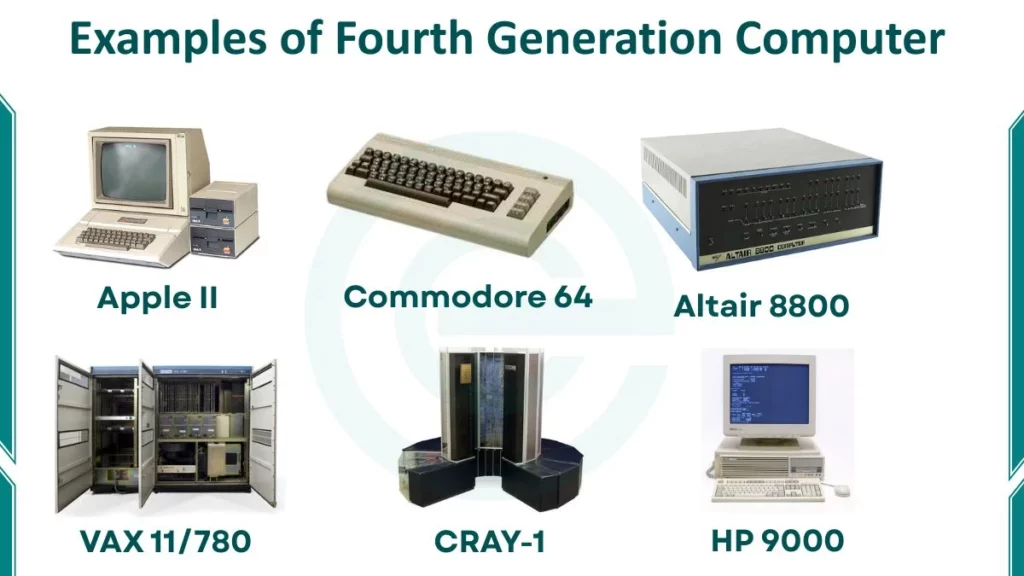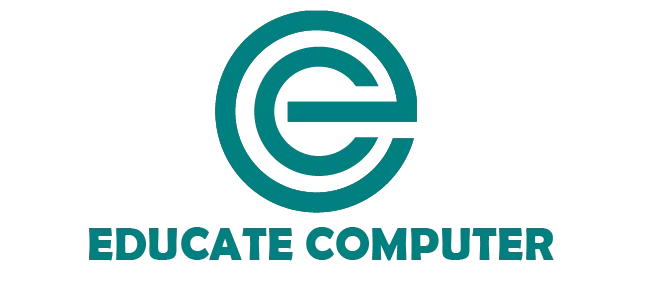Examples of Fourth Generation computers include IBM PC, Apple II, Commodore 64, Altair 8800, VAX 11/780, PDP-11/70, CRAY-1, HP 9000, NEC PC-8001, and TRS-80. We discuss all these examples in detail below.
Fourth-generation computers were built between 1975 and 1989. They used microprocessors instead of integrated circuits. This makes them smaller, cheaper, faster, and more powerful.

Fifth Generation of Computer Examples
The following are examples of fourth generation computer:
- IBM PC
- Apple II
- Commodore 64
- Altair 8800
- VAX 11/780
- PDP-11/70
- CRAY-1
- HP 9000
- NEC PC-8001
- TRS-80
Now, let’s discuss each example in detail.
1. IBM PC
IBM PC was introduced in 1981 by International Business Machines (IBM). It is one of the most iconic personal computers that brought computing into homes and offices.
The IBM PC sets a global standard for personal computers and becomes the foundation for most modern desktop systems.
Features of IBM Pc:
- Uses a microprocessor (Intel 8088) as the CPU.
- Compact and affordable design.
- Includes floppy disk storage.
- Runs MS-DOS operating system.
- Supports keyboard and monitor for input and output.
Purpose:
IBM PC is used for office work, education, and home computing. It handles word processing, spreadsheets, and database management.
Example Insight:
IBM PC becomes a global standard and sets the foundation for the modern personal computer industry.
2. Apple II
Apple II was launched in 1977 by Apple Computer Inc. It was designed by Steve Jobs and Steve Wozniak. It is one of the first highly successful mass-produced personal computers. Its user-friendly interface, color graphics, and expandability make it popular among both students and professionals.
Features:
- Uses a microprocessor (MOS 6502).
- Includes color display and sound output.
- Uses floppy disks for storage.
- Supports BASIC programming language.
- Easy to use for home and school purposes.
Purpose:
Apple II is used in education, small businesses, and personal projects. It becomes popular in classrooms across the U.S.
Example Insight:
The Apple II revolutionized home computing and established Apple as a leader in the tech world.
3. Commodore 64
Commodore 64 was introduced in 1982 by Commodore International. It becomes one of the best-selling home computers of all time. Its attractive graphics and sound make it a favorite among students and gamers.
Features of Commodore 64:
- Uses the MOS 6510 microprocessor.
- Built-in color graphics and sound.
- Comes with 64 KB of RAM.
- Connects to a TV or monitor.
- Supports gaming, word processing, and programming.
Purpose:
Commodore 64 is used for entertainment, learning, and basic computing tasks.
Example Insight:
Commodore 64 makes computing fun and affordable for millions of people worldwide.
4. Altair 8800
Altair 8800 was introduced in 1975 by MITS (Micro Instrumentation and Telemetry Systems). It is considered the first personal microcomputer.
It is designed for hobbyists and engineers. Although simple, it inspires the development of future PCs.
Features of Altair 8800:
- Based on Intel 8080 microprocessor.
- Users enter data using switches and lights.
- Supports memory expansion.
- No monitor or keyboard initially.
- Later compatible with BASIC language.
Purpose:
Altair 8800 is mainly used by computer enthusiasts and developers to experiment with programming.
Example Insight:
Altair 8800 sparks the personal computer revolution and inspires companies like Microsoft and Apple.
5. VAX 11/780
VAX 11/780 was released in 1977 by Digital Equipment Corporation (DEC). It is a 32-bit minicomputer that bridges the gap between small computers and mainframes. It is well-known for its high speed, flexibility, and multitasking capabilities.
Features of VAX 11/780:
- Uses advanced microprocessor technology.
- Supports virtual memory.
- Handles multiple users simultaneously.
- Runs VMS operating system.
- Compatible with various programming languages.
Purpose:
VAX 11/780 is used in universities, research labs, and government organizations.
Example Insight:
VAX 11/780 bridges the gap between minicomputers and mainframes with its powerful architecture.
6. PDP-11/70
PDP-11/70 was introduced in 1975 by Digital Equipment Corporation (DEC). It is one of the most powerful and widely used models in the PDP series. It is known for its reliability and expandability. It serves in various technical and educational applications.
Features of PDP-11/70:
- Uses microprocessor-based circuits.
- High-speed performance.
- Supports multiple terminals.
- Built-in error detection system.
- Efficient memory management.
Purpose:
PDP-11/70 is used in data analysis, process control, and educational environments.
Example Insight:
PDP-11/70 continues DEC’s tradition of reliable and versatile computing systems.
7. CRAY-1
CRAY-1 was designed in 1976 by Seymour Cray. It is the first successful supercomputer of the fourth generation. It is famous for its high speed and unique C-shaped design. It represents the peak of computing power during its time.
Features of CRAY-1:
- Uses vector processing technology.
- Performs 80 million calculations per second.
- Compact C-shaped design for efficient cooling.
- Uses magnetic core and semiconductor memory.
- Built for scientific and defense purposes.
Purpose:
CRAY-1 is used for weather forecasting, nuclear research, and large-scale scientific simulations.
Example Insight:
CRAY-1 becomes a symbol of supercomputing power during the 1970s and 1980s.
8. HP 9000
HP 9000 was developed by Hewlett-Packard (HP) in 1982. It is a series of powerful workstations and servers designed for scientific and engineering professionals. It is famous for its strong performance. It is widely used in laboratories and companies.
Features of HP 9000:
- Uses microprocessors from Motorola (68000 series).
- Supports UNIX operating system.
- High-speed performance.
- Expandable memory and storage.
- Designed for engineers and professionals.
Purpose:
HP 9000 is used in scientific research, engineering, and business environments.
Example Insight:
HP 9000 strengthens HP’s reputation for innovation in workstation computing.
9. NEC PC-8001
NEC PC-8001 was developed by NEC Corporation in 1979. It is one of Japan’s first and most successful home computers. It becomes especially popular in Asian markets for education and entertainment.
Features of NEC PC-8001:
- Uses NEC µPD780 microprocessor.
- Built-in BASIC interpreter.
- Connects to a television.
- Compact and affordable design.
- Supports external storage devices.
Purpose:
NEC PC-8001 is used for learning programming, running educational software, and simple business tasks.
Example Insight:
NEC PC-8001 brings affordable personal computing to Japan and influences the design of future Japanese PCs.
10. TRS-80
TRS-80 was introduced in 1977 by Tandy Corporation (RadioShack). It is among the first mass-market home computers. It is designed for both beginners and hobbyists. Its simplicity and low cost make it a household name in the U.S.
Features of TRS-80:
- Uses Zilog Z80 microprocessor.
- Includes keyboard, monitor, and cassette storage.
- Simple BASIC-based operating system.
- Easy to program and operate.
- Affordable for home users.
Purpose:
TRS-80 is used for personal computing, small business applications, and programming education.
Example Insight:
TTRS-80 helps popularize computing among the general public and leads to the rise of home software development.
Also Read:
